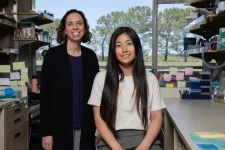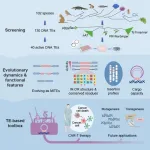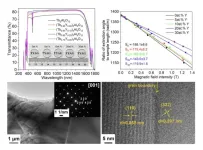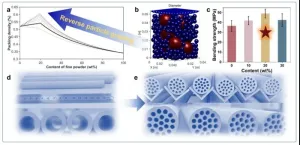About 5% of the world’s population, and one in ten people in the UK1, are currently affected by an autoimmune disease, such as IBD, the umbrella term for Crohn’s disease and ulcerative colitis. These diseases are also becoming more common, with over half a million people living with IBD in the UK as of 2022, nearly double the 300,000 previously estimated2.
Despite increasing prevalence, current treatments do not work in every patient and attempts to develop new drugs often fail due to our incomplete understanding of what causes IBD.
In research published in Nature today, scientists at the Crick journeyed into a ‘gene desert’ – an area of DNA that doesn’t code for proteins – which has previously been linked to IBD and several other autoimmune diseases3.
They found that this gene desert contains an ‘enhancer’, a section of DNA that is like a volume dial for nearby genes, able to crank up the amount of proteins they make. The team discovered that this particular enhancer was only active in macrophages, a type of immune cell known to be important in IBD, and boosted a gene called ETS2, with higher levels correlating with a higher risk of disease.
Using genetic editing, the scientists showed that ETS2 was essential for almost all inflammatory functions in macrophages, including several that directly contribute to tissue damage in IBD. Strikingly, simply increasing the amount of ETS2 in resting macrophages turned them into inflammatory cells that closely resembled those from IBD patients.
The team also discovered that many other genes previously linked to IBD are part of the ETS2 pathway, providing further evidence that it is a major cause of IBD.
ETS2 as a treatment target
Specific drugs that block ETS2 don’t exist, so the team searched for drugs that might indirectly reduce its activity. They found that MEK inhibitors, drugs already prescribed for other non-inflammatory conditions, were predicted to switch off the inflammatory effects of ETS2.
The researchers then put this to the test, and discovered that these drugs not only reduced inflammation in macrophages, but also in gut samples from patients with IBD.
As MEK inhibitors can have side effects in other organs, the researchers are now working with LifeArc to find ways to deliver MEK inhibitors directly to macrophages.
James Lee, Group Leader of the Genetic Mechanisms of Disease Laboratory at the Crick, and Consultant Gastroenterologist at the Royal Free Hospital and UCL, who led the research, said: “IBD usually develops in young people and can cause severe symptoms that disrupt education, relationships, family life and employment. Better treatments are urgently needed.
“Using genetics as a starting point, we’ve uncovered a pathway that appears to play a major role in IBD and other inflammatory diseases. Excitingly, we’ve shown that this can be targeted therapeutically, and we’re now working on how to ensure this approach is safe and effective for treating people in the future."
Christina Stankey, PhD student at the Crick, and first author along with Christophe Bourges and Lea-Maxie Haag, said: “IBD and other autoimmune conditions are really complex, with multiple genetic and environmental risk factors, so to find one of the central pathways, and show how this can be switched off with an existing drug, is a massive step forwards.”
Volunteer participants from the NIHR BioResource, with and without IBD, provided blood samples that contributed to this research. The research was funded by Crohn’s and Colitis UK, the Wellcome Trust, MRC and Cancer Research UK, and the researchers worked with collaborators across the UK and Europe.
Ruth Wakeman, Director of Services, Advocacy and Evidence at Crohn's & Colitis UK said: "Every year, more than 25,000 people are told that they have Inflammatory Bowel Disease. Crohn's and Colitis are complex, lifelong conditions for which there is no cure, but research like this is helping us to answer some of the big questions about what causes them. The more we can understand about Inflammatory Bowel Disease, the more likely we are to be able to help patients live well with these conditions. This research is a really exciting step towards the possibility of a world free from Crohn's and Colitis one day."
Lauren Golightly is 27 years old and was diagnosed with Crohn’s Disease in 2018 after experiencing stomach cramps, blood in her poo and irregular bowel habits.
She said: "Crohn’s has had a huge impact on my life. I’ve had a rocky road since diagnosis, with many hospital admissions, several different medications and even surgery to have a temporary stoma bag. One of the hardest things about having Inflammatory Bowel Disease ( IBD) is the uncertainty around it. I still experience flare-ups and can still spend quite a bit of time in hospital. Learning about this research is so exciting and encouraging. I am hopeful this could potentially make a difference for myself and so many other hundreds of thousands of people living with IBD.”
-ENDS-
For further information, contact: press@crick.ac.uk or +44 (0)20 3796 5252
Notes to Editors
Reference: Stankey, CT., Bourges, C., and Haag, LM. et al. (2024). A disease-associated gene desert directs macrophage inflammation through ETS2. Nature. 10.1038/s41586-024-07501-1.
Conrad, N. et al. (2023). Incidence, prevalence, and co-occurrence of autoimmune disorders over time and by age, sex, and socioeconomic status: a population-based cohort study of 22 million individuals in the UK. The Lancet. 10.1016/S0140-6736(23)00457-9.
Rates of Crohn’s and Colitis have been vastly underestimated for decades, says new study. (2022). University of Nottingham.
The gene desert is located on chromosome 21. The variant of the enhancer linked to IBD, called rs2836882, is a ‘single nucleotide polymorphism’ – where just one base (A,C,T or G) is changed in the DNA. Rs2836882 could bind four times better than other variants to a ‘pioneer factor’ called PU.1, which initiates activation of the gene, allowing it to increase the activity of ETS2 further down the chromosome.
Extra information: why have we evolved to carry a genetic variant linked to chronic inflammation?
The unusual thing about the disease variant in the ETS2 enhancer is that it is very common, with approximately 95% of people with IBD carrying one or two copies of it.
Pontus Skoglund and Leo Speidel in the Ancient Genomics Laboratory at the Crick, which studies ancient DNA, worked with James to shed light on when this genetic variant first appeared, showing that it’s incredibly old, at least 500,000 to one million years old, and was even present in Neanderthals and other archaic humans.
They found that the reason this variant remains so common is because switching on ETS2 appears to be an important part of the early response to bacterial infection. Before antibiotics, this may have had a protective effect during infections, which is probably why so many of us still carry the risk variant today, and why it is even commoner in regions with high rates of infectious diseases.
About The Francis Crick Institute
The Francis Crick Institute is a biomedical discovery institute dedicated to understanding the fundamental biology underlying health and disease. Its work is helping to understand why disease develops and to translate discoveries into new ways to prevent, diagnose and treat illnesses such as cancer, heart disease, stroke, infections, and neurodegenerative diseases.
An independent organisation, its founding partners are the Medical Research Council (MRC), Cancer Research UK, Wellcome, UCL (University College London), Imperial College London and King’s College London.
The Crick was formed in 2015, and in 2016 it moved into a brand new state-of-the-art building in central London which brings together 1500 scientists and support staff working collaboratively across disciplines, making it the biggest biomedical research facility under a single roof in Europe.
http://crick.ac.uk/
END




